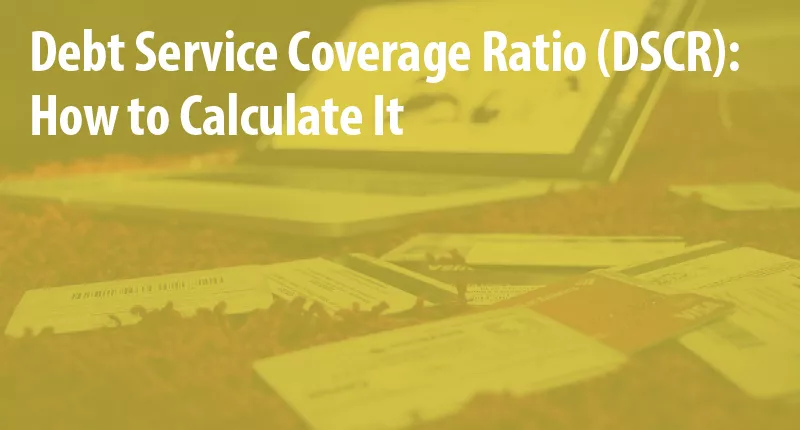
TABLE OF CONTENTS
When it comes to obtaining business funding from a lender, knowing your debt service coverage ratio can really help. Whether you’re starting from scratch or looking to expand, it can be hard to get funding as a small business owner. One of the things lenders really look at is the debt service coverage ratio (DSCR). If you need funding now or plan to acquire some in the future, it’s important to understand your debt service coverage. Knowing this figure will help you determine how to best position your business. Read on to learn how to use the debt service coverage ratio formula to calculate your debt to income ratio.
What is the Debt Service Coverage Ratio(DSCR)?

The debt service coverage ratio is a figure you can use to show your business’s liquidity. It measures the cash flow you have available to pay off any debt you borrow. As you can imagine, lenders take this into serious consideration when deciding if a business will be able to pay back its loans.
While the DSCR isn’t the only thing a lender considers, it plays a significant role in evaluating the business’s likelihood of repayment. It’s a crucial aspect of your loan application. Because of this, the DSCR is a number you should understand and know how to find.
Why is it important?
Knowing your debt service coverage number is important. If it’s below what the lender or financial institution requires, then your loan application will most likely be denied. Make sure you research how to get a business loan, including the basics and applying. If you do not get approval, you may need to seek an alternative business funding solution to secure quick financing. An alternative lender can still help you secure funds for rapid growth periods, to expand, or in an emergency.
How to Calculate the Debt Service Coverage Ratio for Your Business
The great news is that calculating your DSCR number is simple! While some ratio formulas can be tricky, the debt service coverage ratio formula only has two parts.
- Annual Net Reporting Income (NOI): You can find your NOI by subtracting your business expenses from your annual profit. When you file your business taxes, your accountant will have this information in the Profit and Loss Statement. This form will help you find your NOI.
- Annual Debt Obligations: Similar to the NOI, you will calculate this figure by year. Your annual debt obligations are the sum of any loans you owe for the year.
Once you have both numbers, simply divide the annual NOI by the annual debt obligation.
Debt service coverage ratio formula
Once you have the figures for the debt service coverage ratio formula, you can calculate your debt to income ratio. This number will be greater or less than 1.
If the debt service coverage is less than 1, it means the business doesn’t have enough cash to pay off its debts. For example, if the ratio comes out to .95, this means that the business could only pay off 95% of its debts.
On the other hand, if the figure is over 1, this tells a lender the company has more than enough cash to cover repayment. Not only that but there would also be a cushion as well. Why? The average range of a healthy DSCR score is between 1.15 and 1.35. DSCRs in this range are what lenders most often approve.
While debt service coverage ratios are useful in business, there are also similar applications with cash to debt ratios. These numbers help gauge the health of industries, households, and real estate (such as commercial real estate).
Global debt service coverage (Global DSCR)

When it comes to debt service coverage, using the Global DSCR can provide a more complete picture of what the cash flow is like for the business and the business owner. The Global DSCR allows a small business owner’s financial statements to contribute to business loan consideration. For small businesses, this number may be used more often than a standard DSCR. For instance, if a business trying to acquire a commercial property to operate in, the lender may use the global DSCR. This is because the business owner and the business itself are closely tied.
To calculate the global DSCR, you will need to add personal property, income, and expenses to the calculation. This will allow a lender to potentially approve a loan for something like a commercial property. Since combining the borrower’s personal income to an otherwise less than ideal property can improve the ratio, it increases the chance of approval.
Debt Service Coverage Ratio Example
The debt service coverage ratio formula makes it easy to calculate a business’s debt to income ratio. Here is an example to make sure you feel confident applying this formula to your own business.
Let’s say you find that Net Operating Income for 2020 came out to $150,000. in that same year, the total debt obligation was $100,000. The DSCR would be $150,000/$100,000 = 1.5x (the “x” means the debt would be covered 1.5 times or 150% of the time).
Knowing your debt to income ratio is an important component to understand. You can even include it in your business impact analysis to plan out how to mitigate financial risks.
Final Thoughts on the DSCR
While net operating revenues for large enterprises continue to rise, a small business will often experience shifts in its NOI, particularly with external stressors such as global pandemics. As a business owner, you must keep track of your debt service coverage ratio to ensure you will have enough cash on hand to pay back your obligations. If not, it will be very difficult to obtain funding in the future. Start analyzing where your business stands today to gain a better understanding of your financial position. Take the necessary steps now to ensure your business can meet your financial goals.





